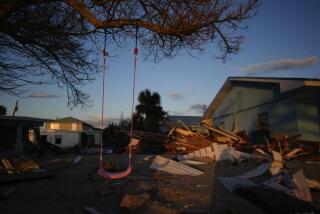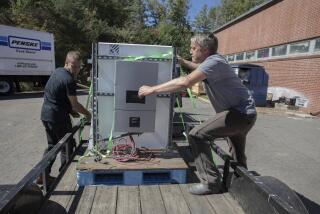Charley may be gone, but toll keeps climbing
7:22 a.m.Early today, 391,000 people remained without power, said Kristy Campbell, spokeswoman at the state emergency management center. One of three hospitals shut down by the storm, Fawcett Memorial Hospital in Port Charlotte, opened today for all services except elective admissions.
An Apopka tree-trimmer died Wednesday and two heat-related deaths in Southwest Florida were linked to Hurricane Charley as a pair of Central Florida utilities hedged their bets on when power will be restored to their frustrated customers.
The latest fatalities, in Orange, Lee and Highlands counties, brought Charley’s death toll to 23, state officials said.
The deaths added even more urgency to the tedious task of returning electricity to homes and businesses in a state where an estimated 800,000 residents still don’t have power.
The scope of recovery problems continued to grow in the 25 counties hardest hit after Charley hit Charlotte Harbor on Friday.
Charley likely will cost insurers at least $7.4 billion, compared with Hurricane Andrew’s $15.5 billion payout, or $20.3 billion in inflation-adjusted dollars, according to the Insurance Institute. The industry trade group based its estimate on initial claims data from Florida residents and businesses.
The storm likely will be the nation’s fourth-most costly disaster for insurers and the second-most expensive hurricane after Andrew, the institute said. Earlier estimates have put storm damage at up to $14 billion.
The Federal Emergency Management Agency opened its primary disaster field office in Orlando on Wednesday. But officials, volunteers and advocacy groups expressed concern that some elderly residents, and migrant and seasonal farm workers, might not be getting the help they need.
Still, FEMA Director Mike Brown, who came to Orlando on Wednesday, said more than $7.5 million in federal assistance funds already has flowed into the hands of hurricane victims. FEMA, which now has 1,191 personnel in Florida, had processed 57,371 applications for aid within the 25-county state disaster area as of Wednesday evening, he said.
The federal government’s primary disaster agency expects to have more than 500 of its employees working just in the Orlando field office within a short period. A satellite disaster-recovery center opened in Lake Wales on Wednesday, with as many as two others expected to be opened elsewhere.
“We are now transitioning from the response phase to the recovery stage,” Brown said. “There is a natural cycle to disasters, and we are in the cranky stage.”
The crankiness meter may continue to rise for Orlando Utilities Commission and Kissimmee Utility Authority customers after those utilities acknowledged that they would not meet their goals of restoring all service by Friday and Sunday, respectively.
Florida Power & Light and Progress Energy officials, however, said they are still planning on making their deadlines for their customers. FP&L had set a deadline of today. Progress had set Saturday as a goal for most customers except Polk County, which has a Sunday target.
Storm-related deaths
Wesley Crawford, 37, a tree climber, died after he fell from a tree onto concrete Tuesday in east Orange County, said his mother, Sandra Holt of Apopka. Holt said Crawford fell about 60 feet from a tree he was trying to cut down. Crawford had been a tree climber for about 18 years and had a 10-year-old daughter.
“I think a limb broke loose and hit the limb he was on,” family friend Linda Hackney said. The other reported deaths included a 74-year-old man in Lee County who died from hypertension and heat exhaustion, and a 55-year-old man in Highlands County who died from heart disease exacerbated by the heat, state Health Department spokesman Rob Hayes said.
An elderly Hardee County man who died earlier in the week from a heart attack also was working in the heat, according to Scotty Sanderson, assistant commissioner of the Florida Department of Law Enforcement.
The deaths followed blunt public warnings the day before from state health officials about the risks of working in Florida’s heat and humidity -- and the risks of generating power in unsafe ways.
A 56-year-old man in Lee County was found dead in his home after he operated his gas-powered generator in an attached shed to keep it safe from looters. He became the third carbon-monoxide-poisoning death since Hurricane Charley knocked out power Friday.
A Winter Haven man and his stepson also died from carbon-monoxide poisoning after using an emergency generator in their home.
Statewide, more than 100 have been treated for carbon-monoxide poisoning since the storm because of improper generator use, officials said. Health officials once again warned that such generators can be hazardous and should never be used indoors.
“As important as generators can be to get your utilities running to provide air conditioning, refrigeration and lights, they can also pose a significant danger when operated in an area without appropriate ventilation,” Hayes said.
More than half of the state’s storm-related deaths have come not from the hurricane itself but from auto accidents, heart attacks and other problems during the cleanup from the storm.
As of late Wednesday, there were six deaths reported from the storm in Polk County, two in Orange County, two in Volusia and one in Osceola.
Officials said it could be a month before the final toll is known because so many don’t have power and because so many elderly residents lived in devastated areas still being checked.
Moving the elderly
Florida Secretary of Elder Affairs Terry White said state officials are moving some elderly residents out of their damaged homes, “in some cases against their will,” because of concerns about leaking roofs, mold and other safety threats from storm damage.
“We’ve had caseworkers go into some homes that are devastated with mold and mildew,” White said. “We’re concerned about their safety.”
White noted that such problems have been reported in Central Florida, as well as Southwest Florida. He urged those with concerns to call the department’s toll-free hot line at 1-800-96ELDER.
Dr. John Agwunobi, secretary of the Department of Health, urged residents to use common sense during the cleanup, including drinking plenty of fluids, taking breaks and protecting themselves against the sun and insects.
Traffic tolls return
Locally, drivers heading to and from east Orange County finally got some relief, but lost a treat late Wednesday. Crews finally got the last of a series of dysfunctional traffic lights working again on East Colonial Drive on Wednesday afternoon.
As a result, tolls were reinstated on the eastern half of the East-West Expressway (State Road 408) on Wednesday night. That segment, from downtown Orlando to State Road 50, had been toll-free since the Orlando-Orange County Expressway Authority lifted all tolls in preparation for Charley last Friday.
The Expressway Authority reinstated tolls on its other expressways Sunday night but kept the tolls off S.R. 408 because Colonial, which runs parallel, was such a mess. Tolls were reinstated on the western half Tuesday night when West Colonial traffic lights came up.
With repairs to the final bad lights at Lake Pickett Road, Chickasaw Trail, Econlockhatchee Trail and Forsyth Road, East Colonial was ready for the homebound rush hour Wednesday night.
Fred Ferrell of the Florida Department of Transportation said all was not yet back to normal. Some Colonial signals were running on portable generators because there still was no power. Others do not have left-turn signals and need to be replaced.
“Everything’s operational,” Ferrell said. “[But] we still have some work to do.”
Scott Powers, Bob Mahlburg, Dan Tracy, Amy C. Rippel and Anthony Colarossi of the Sentinel staff contributed to this report. Wes Smith can be reached at dwsmith@orlandosentinel.com or 407-420-5672.
More to Read
Sign up for Essential California
The most important California stories and recommendations in your inbox every morning.
You may occasionally receive promotional content from the Los Angeles Times.










